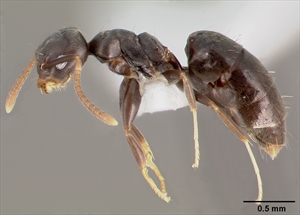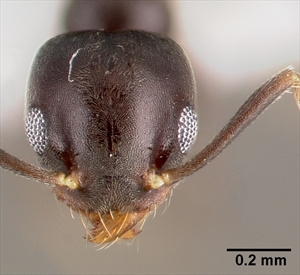- Worldwide distribution. In Australia, Guam, Federated States of Micronesia (Chuuk), Papua New Guinea. Several similar species requiring expert identification.
- Major pest. Damage is indirect: ant protects aphids, mealybugs, scales, whiteflies from natural enemies encouraging pest outbreaks. Nests on ground, in trees, in houses. Does not bite humans.
- Males, winged and wingless; females (queens, workers, 'intercastes'). Queens mate, establish colony; later, reproductive (fertilized) intercastes take over. Foraging by (unfertilized) workers - food is living/dead insects, honeydew, own eggs.
- Tramp ant; spread by 'budding' - intercastes leave nest with workers, males and brood; spread with international horticultural trade.
- Biosecurity: requires risk assessments, regulations preventing introduction, protocols in case of breach, and ability to make rapid response. Pacific Ant Prevention Plan available (IUCN/SSC Invasive Specialist Group).
- Cultural control: hot water at 47°C kills ants; over 49°C kills plants.
- Chemical control: use (i) stomach poisons (fipronil, Amdro®, borax), (ii) growth regulators (methoprene, pyriproxyfen), (iii) nerve poisons (bifenthrin, fipronil, imidacloprid). See (http://piat.org.nz/index.php?page=getting-rid-of-ants).
Pacific Pests, Pathogens and Weeds - Online edition
Pacific Pests, Pathogens, Weeds & Pesticides
White-footed ant - Technomyrmex difficilis (480)
White-footed ant. It is also known as the difficult white-footed ant, or the difficult techno ant.
Technomyrmex difficilis. This ant has been misidentified previously, confused with Technomyrmex albipes (see Fact Sheet no. 360). There are other closely-related species, Technomyrmex pallipes, and Technomyrmex mayri st. nitiduans.
AUTHOR Grahame Jackson
Information from Technomyrmex difficilis Forel, 1892. Atlas of Living Australia. (https://bie.ala.org.au/species/urn:lsid:biodiversity.org.au:afd.taxon:2b32ef9e-a083-42b1-8a0a-93a69330eb7a); and AntWeb, v8.47 (2020) California Academy of Science, online at: (https://www.antweb.org/description.do?genus=Technomyrmex&species=difficilis); and from Warner J, Scheffrahn RH (2010) Technomyrmex difficilis (=albipes) Florel. Featured Creatures. UF/IFAS. University of Florida. (http://entnemdept.ufl.edu/creatures/urban/ants/white-footed_ant.htm). Photos 1-3 April Nobile. AntiWiki (https://www.antwiki.org/wiki/Technomyrmex_difficilis): Photo 1 Head view of ant Technomyrmex difficilis. Photo 2 Profile view of ant Technomyrmex difficilis. Photo 3 Dorsal view of ant Technomyrmex difficilis. Photo 4 Mark Ayers HumanObservation of Technomyrmex difficilis recorded on 2020-04-13. Atlas of Living Australia. (https://biocache.ala.org.au/occurrences/2e38e2c0-4682-4546-89a2-a0f39a2e31ac).
Produced with support from the Australian Centre for International Agricultural Research under project HORT/2016/185: Responding to emerging pest and disease threats to horticulture in the Pacific islands, implemented by the University of Queensland and the Secretariat of the Pacific Community.







